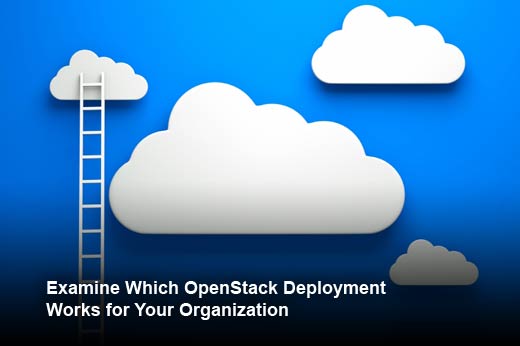Clearly there have been concerns within enterprises about how their cloud infrastructure should be integrated and managed. SUSE sponsored a study that found more than 81 percent of senior IT professionals are planning to move or are already moving to OpenStack private cloud. Those who have yet to move have expressed concerns about implementation, vendor lock-in constraints and a shortage of OpenStack talent in the market. So what can IT do to make their companies less reluctant to pursue the private cloud?
Pete Chadwick, senior product manager, Cloud Infrastructure, SUSE, shares some best practices on leading the way to a production-ready OpenStack cloud solution.
Making the Move to OpenStack
Click through for five tips IT pros can use to prepare for an OpenStack cloud migration, as identified by Pete Chadwick, senior product manager, Cloud Infrastructure, SUSE.
Examine Which OpenStack Deployment Works for You
Because of the complex nature of many projects, users are increasingly turning to managed services and OpenStack distributions to find success in do-it-yourself deployment. More businesses are turning to open source options to deploy private clouds, as this offers a more secure approach to implementing a commercial distribution, with sturdy and stable enterprise-class solutions that meet business needs. Enterprise vendors often test new versions and updates to guarantee compatibility and ensure third-party hardware and software continue to perform flawlessly throughout the entire lifecycle. Refer to this booklet from the members of the OpenStack community – technologists, business leaders and product managers – for a thorough explanation about getting started and planning your path to an OpenStack cloud.
Determine Your Company’s Short- and Long-Term Goals
When it comes to deploying OpenStack solutions, it is important to ask what is your company’s long-term growth strategy? Will the distribution lock you into one vendor or will it offer freedom from such proprietary lock-in? SUSE found 92 percent of IT pros globally have concerns about vendor lock-in when it comes to choosing a private cloud infrastructure solution. Flexibility can be a key advantage when selecting open source solutions, something 63 percent of these IT pros expect. Adaptable solutions can easily cater to individual business needs.
Understanding both your immediate and long-term goals will help you make better decisions for your business.
Do Not Accept Defeat
Ready for a dose of reality? Half of all enterprises that tried to implement an OpenStack cloud have failed, and 65 percent of companies report they have found the implementation experience to be difficult. While it can be easy to throw in the towel after experiencing failure, SUSE’s research found the more adversity companies face in their OpenStack attempts, the more determined they will be to make it a success on their next go-around. According to 88 percent of respondents, the majority of business workloads will be deployed as lightweight containers on cloud infrastructures within five years. By quitting, how far will your organization fall behind?
Embrace Industry Certification and Training Programs
An OpenStack skills shortage is a major barrier when it comes to advancing into the private cloud. In fact, the Linux Foundation’s 2016 Open Source Jobs Report revealed 87 percent of hiring managers say it’s difficult to find open source talent. To combat this, 79 percent have admitted to increasing incentives to hold on to their current open source professionals. This aligns with SUSE’s finding that 78 percent of IT professionals who have yet to adopt the private cloud are being put off by this dire need for talent in the industry.
There is enormous pressure for businesses to innovate faster, and vendors are attracted to the collaborative nature that accompanies open source. While the demand for skilled professionals continues to grow, another resource businesses can look into is engaging the OpenStack Foundation on certification and training programs. The OpenStack Foundation and OpenStack solution providers are always developing a range of training courses and continued expansion of certifications.
Make Use of the Flexible OpenStack Community
People turn to OpenStack for many reasons, but one of the main advantages is flexibility. To fully take advantage of this benefit, IT pros should examine OpenStack distributions that best fit their existing resources and environments.
Enterprises have increasingly deployed multiple hypervisors in their data centers to optimize workload performance and lower licensing costs, so it’s important to choose a distribution that offers support for mixed virtualization environments such as KVM, Xen, Hyper-V and vSphere. In doing so, you are allowing for a more efficient investment in technology and skills, helping to obtain the most value from an OpenStack deployment.








